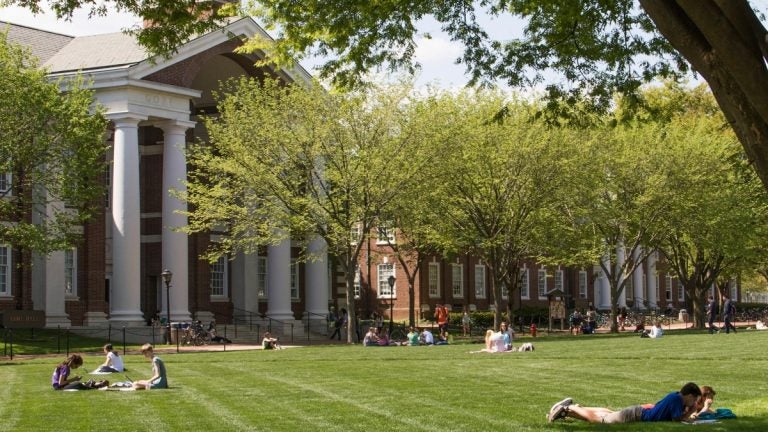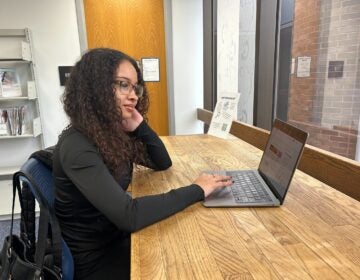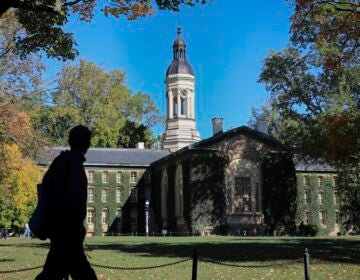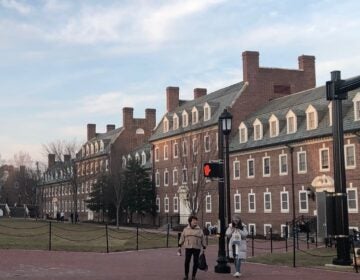Despite outreach efforts, University of Delaware fails to attract black students
The University of Delaware continues to struggle to attract black students and ranks among the nation's worst in enrolling its black high school graduates.
Listen 4:21
The University of Delaware was fifth worst nationally in a study of flagship universities that compares their percentage of black freshmen with its percentage of black public high school graduates in the state. (University of Delaware)
The University of Delaware continues to struggle to attract black students, and ranks among the nation’s worst in enrolling its black high school graduates.
A new state-by-state study of flagship universities by the Hechinger Report shows 33 percent of Delaware public high school graduates in 2015 were black, but only 6 percent of the freshman class at UD was black.
The gap of 27 percent was the fifth highest in the nation, behind only four flagships in the South. The University of Mississippi was the highest, with a 40 percent gap.
Hechinger, a nonprofit news organization focused on education, used data from 2015, the last for which nationwide comparisons were available—and the same year the University of Delaware announced a diversity action plan.
UD’s move came after years of criticism. In 2011, a Middle States Commission on Higher Education report said the University of Delaware “is not diverse in either absolute or relative terms,” and “trails its peers in every measure of diversity in every constituency of the institution.”
Data on this year’s student body collected by WHYY shows some improvements have been made with diversity since 2015, particularly among Latino and Asian populations.
However, the number of black students still lags behind in a state where 21 percent of residents are black.
This year, 5.2 percent of UD’s 18,144 “main campus” undergraduates are black—a fact that troubles state Rep. J.J. Johnson, D-Wilmington, one of four black members of Delaware’s 62-member General Assembly.
“I have major concerns about the African American community, because I think if we were able to address the concerns in the African American community, especially here in Delaware, we would be able to address some of the inequities we have in the state,” said Johnson, one of a few legislators who expressed their concerns about diversity to the university during a meeting a few years ago.
“I’m thinking about African Americans in key positions throughout the state, and looking at the University of Delaware, it’s probably similar to the concerns people have with the state government as a whole.”
Starting in September, WHYY made repeated requests to UD for the latest enrollment data, but the school would not provide the information. Finally, WHYY filed a Freedom of Information Act request to receive data for the current school year. A university official only spoke to WHYY for this story on Monday, after Hechinger published its report.
Carol Henderson, a longtime UD professor who was hired as vice provost of diversity in July 2014, said improvements have been made. She points to its 2017 INSIGHT Into Diversity Higher Education Excellence in Diversity (HEED) award.
UD was one of 80 schools to receive the award from the higher education diversity publication, but not one of the 16 named Diversity Champions.
“I think we’re making great strides. There’s always room for improvement. So, while we’re not where we’d like to be, national recognition went a long way to say we’re on the road to improvement,” Henderson said. “So, we are making progress. This office works very hard. I’ve seen a shift in the culture here. I’ve seen a renewed focus in the executive leadership team to advance inclusive excellence in all parts of our campus.”
Jimi Issa, a junior at the university who is black and Muslim, said he finds his community service fraternity and the school’s Student Center, where he holds a job, make a noticeable effort to ensure diversity.
He said the school can do better, though.
“As a campus as a whole, I don’t believe we’re making an improvement. It’s slight if any,” Issa said. “I do [think the university is trying], but I don’t know how well their efforts are. I know there’s some work to be done.”
Racial Disparity Rankings (Fall 2015)
| Flagship University | Percent black In-state H.S. grads | Percent of black freshmen | Percentage point difference |
| University of Mississippi | 50% | 10% | 40% |
| University of South Carolina-Columbia | 37% | 6% | 31% |
| University of Georgia | 38% | 8% | 31% |
| Louisiana State University and Agricultural & Mechanical College | 44% | 13% | 31% |
| University of Delaware | 33% | 6% | 27% |
| The University of Alabama | 35% | 10% | 25% |
| University of Maryland-College Park | 36% | 12% | 24% |
| University of North Carolina at Chapel Hill | 27% | 7% | 20% |
| The University of Tennessee-Knoxville | 25% | 7% | 18% |
| University of Arkansas | 22% | 4% | 18% |
| University of Florida | 23% | 6% | 17% |
| University of Virginia-Main Campus | 23% | 7% | 17% |
| University of Michigan-Ann Arbor | 18% | 5% | 13% |
| University at Buffalo | 18% | 7% | 11% |
| University of Illinois at Urbana-Champaign | 18% | 6% | 11% |
| Ohio State University-Main Campus | 16% | 4% | 11% |
| Pennsylvania State University-Main Campus | 15% | 4% | 11% |
| Rutgers University-New Brunswick | 17% | 7% | 10% |
| The University of Texas at Austin | 13% | 5% | -9% |
| University of Missouri-Columbia | 17% | 8% | -9% |
| University of Wisconsin-Madison | 9% | 2% | -7% |
| University of Connecticut | 14% | 7% | -7% |
| Indiana University-Bloomington | 12% | 5% | -7% |
| University of Minnesota-Twin Cities | 10% | 3% | -7% |
| U.S. Average | 16% | 5% | 11% |
Universities across the U.S. fall short
The University of Delaware, whose sprawling main campus is home to stately columned brick buildings, is not alone among flagships who fail to enroll black students.
Hechinger, which partnered with WHYY for this story, found many of the nation’s best public universities are enrolling disproportionately few African-American and Latino students.
These flagship universities have sought-after faculty, preeminent research facilities, the most resources and often the highest graduation rates, for all races. They also stand as beacons of affordable excellence for the students of their states.
But when it comes to equitably serving the state’s residents, whose taxes fund these top-flight universities, many fall short of their stated missions.
Often there are big differences — defined by race — between who’s graduating from a state’s public high schools and who’s getting into its flagship universities.
The Hechinger report shows more than a third of U.S. states had at least a 10-point gap – including eight with a 20-point gap — between the percentage of their public high school graduates who are African-American and the percentage of their flagships’ freshman class who are African-American.
Following the University of Mississippi at 40 percentage points, three schools have a gap of 31 percentage points — University of South Carolina-Columbia, University of Georgia and Louisiana State University.
National rankings for the other flagship universities in the region:
* Seventh worst was the University of Maryland-College Park, with a 24 percentage point gap.
* Penn State’s main campus was 17th worst nationally, with an 11-point gap, same as the U.S. average.
* New Jersey’s flagship university, Rutgers, was 19th worst, with a 10-point gap.
Hechinger also calculated rates for four Philadelphia universities. The school with the highest percentage of black students was Temple, with 12 percent. Next was Penn, 7 percent, followed by Villanova, 6 percent, and Drexel, 5 percent.
For Latinos, 10 states had at least a 10-point gap, but none were in the region. The highest was Rutgers, which had an 8-point gap – 21 percent of Latino graduates vs. 13 percent of incoming freshmen.
The gap for Latinos was 3 percentage points at Delaware, and 2 percent at Penn State and Maryland.
Attending a flagship university gives students a leg up on their peers, educational experts say.
“It matters who’s enrolled at flagships, because they tend to go on to be leaders in their states, particularly in politics and in business,” said Andrew Nichols, director of higher education research and data analytics at The Education Trust, an advocacy group that focuses on college access.
“It’s important for everyone going to these universities that they are diverse.”
Going to a flagship university also benefits students financially. Most flagships have larger endowments, allowing them to offer more generous scholarships and provide more robust academic and social support to students. And later on, in many states, the average earnings for graduates from flagships outpace those of graduates from most of the state’s regional public universities and colleges.
Racial Disparity Rankings (Fall 2015)
| Flagship University | Percent Latino In-state H.S. grads | Percent of Latino freshmen | Percentage point difference |
| University of California-Berkeley | 51% | 13% | 38% |
| The University of Texas at Austin | 48% | 22% | 26% |
| University of Nevada-Reno | 38% | 19% | 19% |
| University of Colorado Boulder | 30% | 12% | 18% |
| University of Arizona | 42% | 24% | 18% |
| University at Buffalo | 22% | 7% | 14% |
| University of Rhode Island | 21% | 10% | 12% |
| University of Washington-Seattle Campus | 18% | 7% | 11% |
| University of Connecticut | 19% | 8% | 11% |
| University of Illinois at Urbana-Champaign | 21% | 11% | 11% |
| University of Nebraska-Lincoln | 16% | 7% | 9% |
| University of Massachusetts-Amherst | 15% | 6% | 9% |
| Rutgers University-New Brunswick | 21% | 13% | 9% |
| University of Kansas | 16% | 8% | 8% |
| University of Florida | 28% | 21% | 7% |
| University of Oregon | 20% | 13% | 7% |
| University of New Mexico-Main Campus | 58% | 52% | 6% |
| University of Virginia-Main Campus | 11% | 6% | 6% |
| University of Georgia | 11% | 6% | 5% |
| University of North Carolina at Chapel Hill | 11% | 7% | 4% |
| University of Idaho | 16% | 12% | 4% |
| University of Wisconsin-Madison | 9% | 5% | 4% |
| University of Oklahoma-Norman Campus | 12% | 9% | 3% |
| University of Delaware | 11% | 8% | 3% |
| University of Maryland-College Park | 11% | 9% | 2% |
| Pennsylvania State University-Main Campus | 9% | 7% | 2% |
| U.S. Average | 23% | 10% | 13% |
‘There’s some work to be done’
This year, the University of Delaware has been touting its improved diversity on campus, reporting this year’s class as the most diverse in history, with 20 percent more students who identify as an underrepresented minority.
Still, of the 18,144 students on “main campus” this school year, more than 78 percent are white, according to fall 2017 data analyzed by WHYY.
While the Hispanic population has increased by 87 students since school year 2016, and Asian students increased by 24 in that same time period, the number of black students, 951, remains stagnant.
The current number of black students is the same as the last school year — but since the total student population increased, the actual percentage fell, by 0.2 percent.
And while there are 25 more African American students than in school year 2015, the percentage is still 0.1 percent below what it was two years ago because of increased enrollment.
Of the 4,306 “main campus” freshmen in this year’s class, about 71 percent are white.
There are 218 black freshmen – more than 5 percent. The number of black freshmen increased from 181 in 2016, but data analyzed by WHYY shows that numbers fluctuate year after year for all races.
Rep. Johnson said at the end of last year he had conversations with Henderson and her staff.
“Has it improved as much as I would have liked it to improve? No. But they are making an effort,” he said.
Freshman enrollment data suggests either a gap in outreach to students of color, or a lack of interest from students of color. Of the 27,507 students who applied to the university’s “main campus” for this school year, about 68 percent were white.
About 72 percent of white applicants were offered admission to the university, but only 26 percent accepted offers.
By contrast, 50 percent of minority applicants were accepted into the university’s “main campus,” and more than half of those accepted the offer.
Only about 34 percent of black applicants were offered admission into the university’s “main campus,” and only about 30 percent of those accepted the offer.
“I think they’ve started [outreach] and have done it, but I think they could do a bit more. It all starts with K through 12 in our community, and I think they should be reaching out,” Johnson said.
“I think in a lot of areas, [African American students] feel defeated before they even apply. They have apprehensions as far as applying. And I think that means the university needs to reach out more to the community and address that anxiety.”
Henderson said she can’t say with certainty why the African American population is low, but called it a national trend. She adds the university is competing with several other institutions.
“African American students have a choice to attend where they will, and excellent students are in demand. So, we put our hat in the ring to attract local students, but as with any student who is raised in the state they’re in, many choose to experience other parts of the country, and sometimes those packages look better than ours—that’s just fact. So, students can be wooed away from the state of Delaware,” Henderson said.
“It could be the program they’re seeking to enroll in. We are a flagship institution, and we do well academically, but if you’re competing with Rutgers, or Harvard, or Princeton, or Yale, or University of Maryland, Georgetown, CUNY, University of Pennsylvania, we compete with all those schools in this region, and that’s a pretty great company to be in, but it means the competition for outstanding students of color is intense.”
UD’s action plan
In 2015, the university announced several plans to improve diversity among its students, faculty and staff.
The University’s College of Arts and Sciences said $1 million of its budget has been committed to the issue. A university spokeswoman said the majority of the funding has been used to recruit new faculty and retain established faculty members from underrepresented groups.
In addition, money has gone to a summer workshop for diverse graduate students, and a scholarship fund dedicated to improving diversity in the field of disaster studies.
The state also made plans for an independent diversity study of the university in 2015. However, those plans have stalled.
The state Office of Management and Budget said it moved forward with a professional services procurement process and made a recommendation of a vendor, but state Sen. Harris McDowell, D-Wilmington, objected to having university representatives on the selection committee and with the recommended vendor not being knowledgeable about Delaware.
The university did release a 32-page diversity action plan, however. The plan includes goals to recruit a more diverse faculty and staff, create an environment that promotes more student success—such as mentoring, career planning and pre-college outreach — multilingual programing, a curriculum appreciating “human difference,” as well as several efforts to engage in the community.
A status report by the university shows it has made progress on several goals, including creating a hiring protocol, evaluating its multicultural courses and making new hires.
Dr. Freeman Williams, vice president of the NAACP’s Newark chapter, said the group met with several university representatives to discuss plans to improve diversity, as well as its relationship with the Newark community.
The branch is interested in partnering with the university on student advancement and a community engagement scholars program.
Prior to Williams’ involvement in the chapter, the group had expressed its concerns to the university in a letter.
“There’s been a real willingness to partner and sit down at the table and do some things. To this point they’re making some real positive steps,” said Williams, who has bachelors, masters and doctoral degrees from the university.
“Is everything perfect? Of course not. Is there a lot of work ahead of us? Of course, but I think there’s a real willingness and cooperative attitude and atmosphere with all the parties involved.”
Going forward, Williams said the university must upgrade and expand its recruitment efforts.
“You have to sell students on why coming to the university is going to be a good choice and why the environment is going to be conducive and support their academic development, and their social development as well, and reinforce to them it’s going to be an environment where they’re going to be successful and to be able to convey and convince parents and guardians the university is the appropriate choice,” he said.
“That may mean the university may have to experience doing some kind of nontraditional recruiting in non-school and other environments, for example church environments, community areas. There are organizations African American families are affiliated with the University of Delaware could network with. I think the other thing the university can do is use existing students who can be some of the best ambassadors and sales persons as to why a University of Delaware experience is a positive experience for a student of color.”
Issa said he doesn’t believe the university took enough corrective measures to a couple incidents on campus surrounding racism. He points to an occurrence in 2015 where university police determined three noose-like items were not a hate-crime but remnants from a celebration the night prior. Issa also said a couple students used the social media site Yik Yak to make offensive comments about Delaware State University, a historically black campus.
However, he said incidents like this are rare, and said he enjoys attending UD despite the issues of diversity.
“I’m not going to lie, I love being on campus. Of course, I wish there was more diversity, but I still love it no matter what,” Issa said. “Being a double minority on campus I’d say if I ever witnessed any racism, it was very subtle. While there are definitely problems…it’s still a very open-minded campus.”
WHYY is your source for fact-based, in-depth journalism and information. As a nonprofit organization, we rely on financial support from readers like you. Please give today.






